Mad Dog Moxley (5 page)
Authors: Peter Corris

WILLIAM MOXLEY'S HOSPITAL ADMISSION CARD AND WARD REPORT, OCTOBER 1930
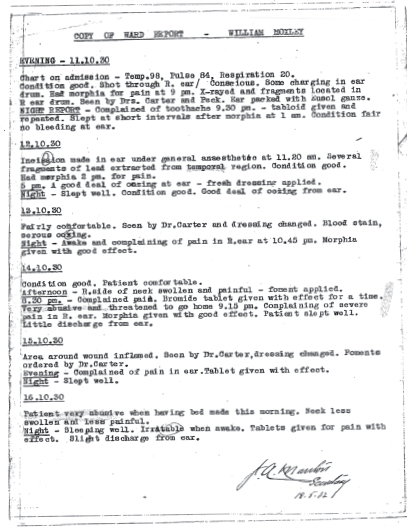
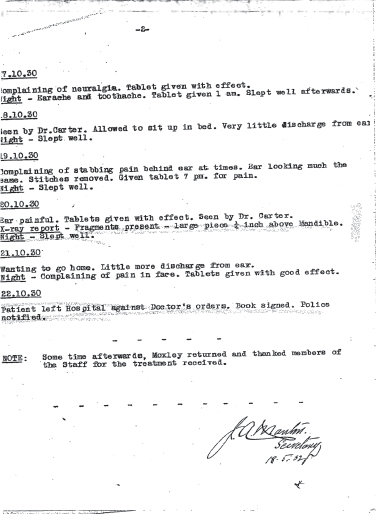
âTake me to a hospital, mate,' he gasps. âI've been shot.'
The motorist, whose name is Murray, is worried that a man who claims to have been shot might have a gun himself. He drives Moxley to the Parramatta District Hospital.
THE HUNTED AND THE HUNTERS
In regard to the condition of the
county, as far as undergrowth
is concerned, I should say it was
rather heavily scrubbed country
DETECTIVE SERGEANT T HILL
Two young people had gone missing, and the story of their disappearance captured the attention and imagination of Sydneysiders. The papers carried reports of the couple with their photographs as well as statements from their relatives that they had not eloped and had no reason to conceal themselves. Following a report that a couple answering the description of Frank Wilkinson and Dorothy Denzel had checked into a Singleton hotel for one night, the police briefly entertained the idea that the couple had run away together, but the lead proved to be false.
The police did not find it difficult to identify Moxley as a suspect after the violent crime and his movements were not difficult to track; they were not calculated to save him from capture. With possession of the Alvis sports car and lorry he had a need for petrol so stole some, leaving traces of his presence. The tin he used to steal the fuel was kept in the Alvis.
At the time, Moxley was living in Burwood as a lodger, in a house rented by a woman named Linda Fletcher, with whom he had a friendly relationship â although some people thought it was rather more than that. He had a 14-year-old son named Douglas, whom Mrs Fletcher minded a good deal of the time. It is not known whether Douglas was Moxley's son by the woman he had married in England.
Moxley left his lorry in the yard of the Burwood house and drove the Alvis to Ashfield, where he rented a garage. He began the process of stripping the car of certain parts â the carburettor, the tyres, the generator, the magneto â and offering them for sale to mechanics and garages in the area. He left the torn rug and the hessian mask in the rented garage. His appearance was distinctive enough, with his mop of fair hair and prominent ears, but he also had a noticeably damaged hand. Several of the people he encountered at this early stage â when the alarm was raised about the missing couple - observed that his fingers were bruised and a nail was torn away. He explained the injury by saying the cranking handle on his truck had kicked and struck him.
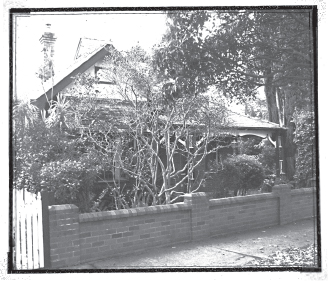
THE HOUSE AT 29 ARCHER STREET, BURWOOD, WHERE WILLIAM MOXLEY WAS LIVING IN APRIL 1932
Moxley paid 5 shillings rent for the garage and managed to sell one spare part for 10 shillings and another for £1. Asked to sign a receipt for this amount, he said he was unable to on account of his hand and he had the buyer sign it in his stead as
C Heath
Each of the people he approached regarded his manner as suspicious. Urged by one of these contacts and by Mrs Fletcher to have his hand attended to, Moxley went to the Parramatta District Hospital where the wound was dressed and bandaged. According to the doctor he had contusions to the third and fourth fingers of one hand and severe bruising to the little finger. The nurse later reported that his manner was nervous - but that was nothing unusual in her experience. He gave his name as Fletcher, his correct address, and the same account of the cause of the injury.
Frank Wilkinson's father offered a reward of £200 (perhaps the equivalent of $20 000 today) for information leading to the discovery of the couple, alive or dead, and in the latter event for the capture of whomever was responsible. The police announced that foul play was suspected. At this time Moxley began to follow the newspaper reports and his anxiety mounted.
Four days after the crime, he left the Burwood boarding house and rented a room in Belmore, paying 8 shillings for the room and breakfast and agreeing to pay 1 shilling for any other meals he might have. He carried a kitbag and something wrapped in a grey blanket. When asked what it was, he said it was a gun. Rabbits abounded then in the outer suburbs of Sydney and were welcome additions to the table during the Depression. And a timber hauler might well need a gun to deal with snakes. George Bakewell, the owner of the house, made no comment.
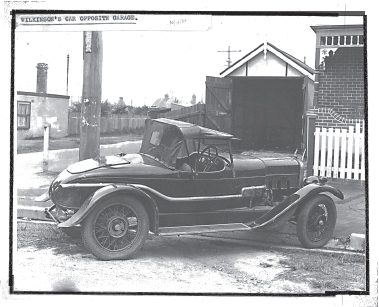
FRANK WILKINSON'S ALVIS CAR
Moxley attempted to conduct himself in a normal manner. He said his hand injury kept him away from his work as a wood cutter and hauler, had a haircut and shave, and left a pair of shoes to be mended. He ate several meals at the Belmore house. But he knew he was on borrowed time. He knew that the earth covering the bodies was a mere 3 inches thick and that the area where they were buried, though concealed, was not remote and was subject to traffic on foot and by horse and motor. On reading the
Daily Telegraph
report on the search for Dorothy and Frank, Moxley remarked to Bakewell, âPeople never know what can happen when they get off the main road.'

Under increasing pressure from the newspapers, the police mounted an intense search for traces of the missing couple. Pieces of physical evidence began to be found: the covering of a car's internal light wrapped in a woman's beret, a garden spade in the middle of Milperra Road. Reasoning that the Alvis was a distinctive car - likely to be seen and difficult to conceal - the police published a detailed description of it, including its number plates. The strategy paid off as sightings began to filter in, from those who had seen it at Strath-field and Moorebank, and from the garage attendant who had sold Moxley the petrol in the early hours after the murder. Within a couple of days two of the people Moxley had approached to sell spare parts came forward, as did the man who rented him the garage. Their physical descriptions matched. Moxley was well known to the police as a habitual criminal and his wounding in 1930 was fresh in some memories. His photograph appeared in the press.
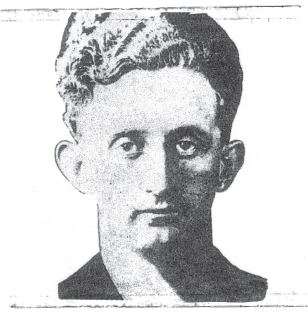
WILLIAM MOXLEY, 1925 PHOTOGRAPH RELEASED TO NEWSPAPERS
Police found the hessian mask in the garage along with the torn and bloodstained rug. A sharp-eyed detective expressed the opinion that dirt on and in the car resembled that in the vicinity of the Holsworthy Army Reserve. The police search concentrated on that area and on 11 April a party of police from Liverpool searched the scrubland in the vicinity of Illawarra Road and its adjacent tracks. A constable reported that they saw car tracks and followed them:
I then saw stains under a tree which resembled blood stains. I then saw bushes piled up 5 or 6 feet from the treeâ¦I pushed these bushes aside and with a stick I was carrying I dug a hole about 2 inches into the ground. I saw three human fingers.
The constable alerted a detective and a guard was placed at the site. Later that day Frank Wilkinson's body was uncovered. It was lying face down. Hardened police were shocked at the injuries.
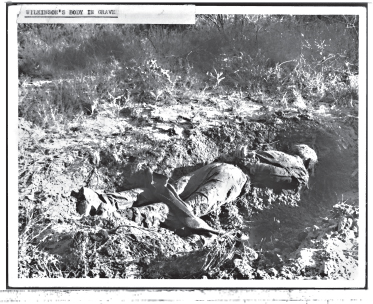
THE BODY OF FRANK WILKINSON IN GRAVE
The discovery of the body had a dramatic effect on people and places of business in the Moorebank area. Several shops and factories closed out of fear that a killer was on the loose, but some members of the public took it upon themselves to search for Dorothy Denzel's body. One such person was Philip Albert Hanley, a railway ganger from Liverpool, who rode his horse to the area where Wilkinson's body was found and searched the scrub. (Why the police did not conduct an extensive search themselves is not clear; probably they were working on the assumption that Dorothy Denzel had been abducted and taken elsewhere.)
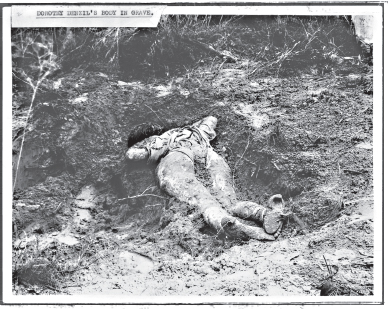
THE BODY OF DOROTHY DENZEL IN GRAVE
Hanley, on horseback, could see over the scrub and he noticed a mound of piled-up dead and dry branches covering a place where the earth had been disturbed. âI took it,' he testified, âthat that was where the girl would be.' Hanley flagged down a motorist and instructed him to contact the police. He added one detail to his otherwise matter-of-fact account: âThe horse shied a little and sniffed when I brought it up to the mound.'
